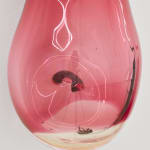Nona Inescu
14 1/8 x 4 3/8 x 4 3/4 in.
Further images
Nona Inescu's Nepenthes sculptures are made of hand-blown glass to evoke the fluid and bulbous forms of the Nepenthes plant, a genus of carnivorous plants. Known for their deep, vase-like traps filled with digestive enzymes, Nepenthes have evolved a highly specialised relationship with their environment, attracting prey with the scent of their nectar. This evolution, which depends on the environment, symbolises the symbiotic relationships between humans and nature that Inescu explores in her exhibition Daisyworld.
In contrast with the deadly nature of the plant, its voluptuous shape and beauty create a dualistic tension. This feeling is reinforced by the delicacy of the material the sculpture is made of, clashing with the lethal behaviour of the plant. In a tragic twist of irony, a wasp (or hoverfly), likely lured by the sculpture's vibrant colour, mistook it for a real flower and got trapped inside. With Nepenthes, Inescu hints at reconsidering the entangled futures of humans and the ecosystems they inhabit, imagining speculative narratives that contemplate the future of our interconnected world.
Exhibitions
Daisyworld, Brooke Benington, London, UK (2024)The Venus Trap, solo presentation with SpazioA Gallery at fiac! (2021)








